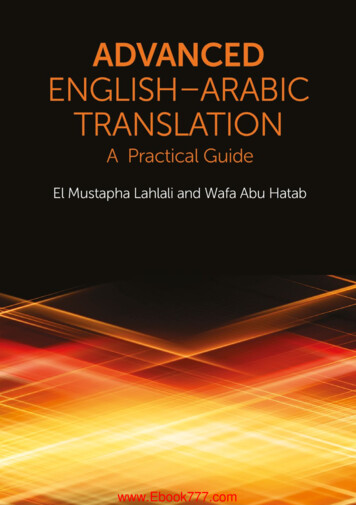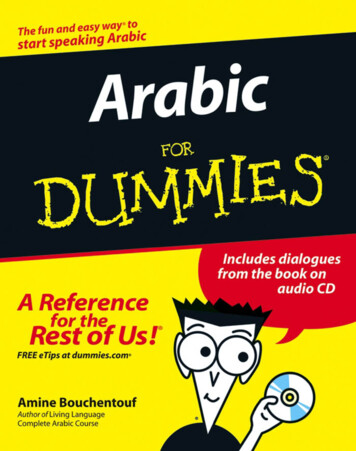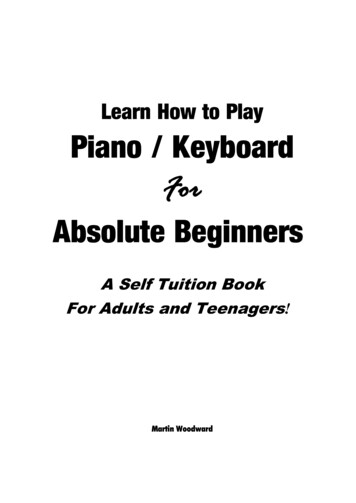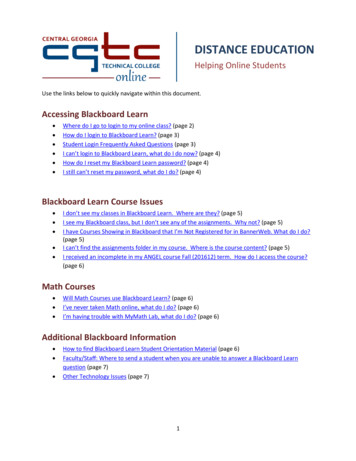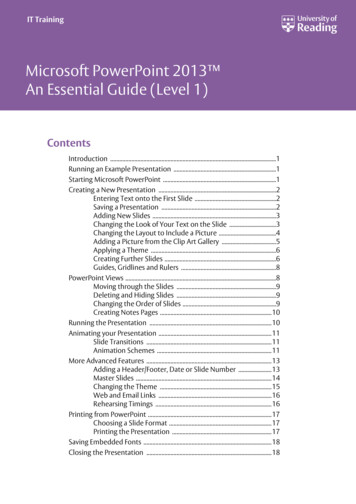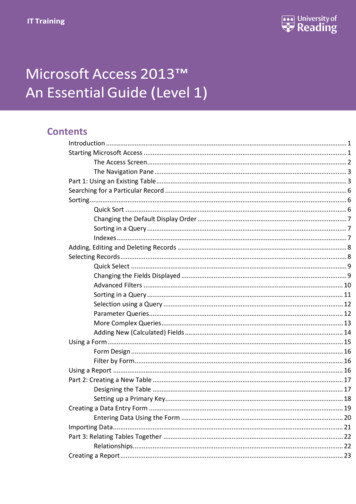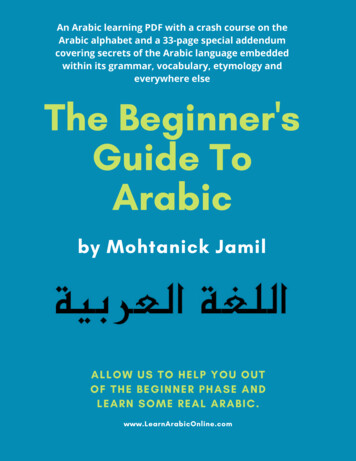
Transcription
An Arabic learning PDF with a crash course on theArabic alphabet and a 33-page special addendumcovering secrets of the Arabic language embeddedwithin its grammar, vocabulary, etymology andeverywhere elseThe Beginner'sGuide ToArabicby Mohtanick JamilALLOW US TO HELP YOU OUTOF THE BEGINNER PHASE ANDLEARN SOME REAL ARABIC.www.LearnArabicOnline.com
The Beginner’s Guide to ArabicBy Mohtanick JamilGUIDE TO STUDYING ARABIC3WHY STUDY ARABICHOW TO STUDY ARABICWHERE TO STUDY ARABICWHAT YOU NEED BEFORE YOU START36910THE ARABIC ALPHABET11INTRODUCTION TO THE ALPHABETTHE LETTERSTHE VOWELS111423SOME BASIC VOCABULARY26RESOURCES FOR LEARNING ARABIC33ONLINERECOMMENDED BOOKS3335JOIN OUR 3-PART MINI-CLASS37WHY IS ARABIC HARD?HERE’S WHAT YOU’LL LEARN3738OUR NEWSLETTERS41 Shariah Program Inc. FREE VIDEO SERIES Reveals How to Read ArabicWith Understanding in 21 Days!
Guide to Studying ArabicWhy Study ArabicArabic is spoken as a mother tongue by between 250 and 400million people across 25 countries. Over a billion people canread the script even if they can’t understand the language. AndArabic happens to be one of the official languages of the UnitedNations. Therefore, many people learn the language for formalreasons.At about 1,500 years old, Arabic also happens to be a very oldlanguage. It was the language of scholarship throughout therule of the Islamic empires – a period of well over 1,000 yearsfrom the 7th century right down to the 19th and even 20th. Thegreatest books of medicine, geology, law, philosophy, andbasically any subject you can imagine were all written in thefinest Arabic. Therefore, many of the most advanced people intheir fields of study learn Arabic for scientific andanthropological reasons.Arabic is also the language of the Qur’an (the Islamic holybook). It doesn’t matter what your beliefs are, the Qur’an isunequivocally, undeniably and undoubtedly the greatest formof Arabic literature, and indeed the greatest form of literature,period. The beauty of this piece of literature is, in fact, quite Shariah Program Inc. FREE VIDEO SERIES Reveals How to Read ArabicWith Understanding in 21 Days!
literally, miraculous. Therefore, tens of millions of people learnthis language to witness firsthand the beauty and miracle thatis The Qur’an. religious reasons.In fact, emphasis has been placed on studying the Arabiclanguage by the Prophet (PBUH) himself when he said to theeffect: learn the Arabic language as you learn the Islamicobligations and practices. His companions, who, remember,were Arabs, used to learn Arabic despite the fact that it wastheir mother tongue. They used to say: teach your childrenArabic. They used to correct each other’s grammar. They wouldconsider it unacceptable to make a grammatical mistake. Andthe scholars that followed them in later centuries allemphasized learning Arabic. Imam Abu Hanifa said to theeffect: I would’ve made learning this language compulsory had Inot deemed it difficult on the people.That is because1. in order to truly understand the message of God as it wasrevealed, one must understand it in the very language itwas revealed, and2. the Qur’an is a literary miracle – really, a full blown miracle– and in order to witness it, you need to simply learn thelanguage and you will witness a miracle with your veryown eyes Shariah Program Inc. FREE VIDEO SERIES Reveals How to Read ArabicWith Understanding in 21 Days!
When the tribe of Qureish in ancient Arabia sent their mostinfamous debater to the Prophet (PBUH), the debater barkedand barked and barked. He was enthusiastic and completelyvicious. His mission was to completely overtake the Prophet(PBUH) and he was relentless. But when he finished, theProphet (PBUH) recited a few verses of the Qur’an, upon whichtears started to flow from the debater’s eyes and he had tocover the Prophet’s (PBUH) mouth because he couldn’t takeany more. Would you like to taste the same beauty that madethat debater cry? Shariah Program Inc. FREE VIDEO SERIES Reveals How to Read ArabicWith Understanding in 21 Days!
How To Study ArabicHow you study the language depends largely on why you’restudying it. If you’re studying the language to be able tocommunicate informally with friends, for example, then thebest place to start for this purpose is to enrol in a short termclass (about 6 months to 1 year) where you will be taught acolloquial dialect of Arabic. There are many dialects, but theEgyptian is most popular and most widely recognized.Whether the course is in person or online doesn’t make adifference in our opinion. But the course must have a liveteacher of native Arabic descent, offer plenty of conversationalpractice and place high emphasis on out-of-class work. Theseare courses that get their students to watch subtitled movies,pair them with native speakers for practice and even offerexchange programs.If you are studying the language for formal purposes, on theother hand, you will need a more formal regiment. You will berelying more on books and placing more attention on grammarrather than your ability to speak fluently. The ability to speakcasually and fluently will come later. And the studies will lastlonger than a year or two; perhaps as much as 4 years.Most universities and colleges offer Arabic language courses.Some even span 3 or 4 years. Most of these are quite good andwill give you a firm grounding in Modern Standard Arabic to the Shariah Program Inc. FREE VIDEO SERIES Reveals How to Read ArabicWith Understanding in 21 Days!
point where you can eventually acquire a formal position suchas translator, etc. But remember, just because there is moreemphasis on grammar, doesn’t mean you don’t have topractice. You will need to set aside several hours for practiceand eventually work on your ability to converse in Arabic.A note of caution: The wrong thing to do when studying Arabicformally is to purchase a few books and start learning on yourown. Many books claim that you can use them for self-learning,but let’s get real. What you need is a medium or long termcourse with plenty of hours of instruction and lots of practiceon your own time. Pick the course and/or book that’s mostconvenient for you, but don’t try to do it all on your own.Finally, if you are studying Arabic in order to understand theQur’an or works of classical scholarship, you will need to masterClassical Arabic. There are several courses around the worldthat offer mastery in Classical Arabic, but it is not worthquitting your job and joining these schools full time. What isbest is a medium or long term online course with teacherinteraction. You will be relying heavily on books and will needto prepare for each lesson by reading ahead before classes.You will cover at least 5 different subjects just on the ClassicalArabic language:1. Grammar –phrases and sentences2. Morphology and Etymology – verbs and conjugation Shariah Program Inc. FREE VIDEO SERIES Reveals How to Read ArabicWith Understanding in 21 Days!
3. Cantillation – pronunciation4. Literature – practice, exposure to different styles ofwriting, idioms5. Logic – a prerequisite for further studies6. Rhetoric – literary devices and beautifying speech7. Poetry – an understanding of Arabic poetry and culture Shariah Program Inc. FREE VIDEO SERIES Reveals How to Read ArabicWith Understanding in 21 Days!
Where To Study ArabicAs mentioned, the wrong thing to do is to try and study on yourown. You need to join a class. If you study informal or formalArabic, a university or college course is usually the safest bet.Find a college near you and read up on their Arabic programs.There are a few good online courses out there, but they are abit dodgy and not necessarily as well established.If you are studying Classical Arabic, you probably have only twochoices: 1) join a full time program that will require you to takea few years off of work and pause your life, or 2) take a parttime course online.You may be thinking of attending a college or university coursepart time or learning from a native speaker for Classical Arabic.But don’t be fooled. Although Modern Standard Arabic andClassical Arabic are very similar, understanding the Qur’an andthe depths of Classical Arabic cannot be done so easily;universities are not equipped to deal with this and native Arabsdon’t necessarily understand the language at this level.You need the absolute best education by the absolute bestteachers in the most advanced manner. Regular courses can’tgive that to you and native Arabs speak the language but theydon’t necessarily understand its most intricate details. youneed a proper method. Shariah Program Inc. FREE VIDEO SERIES Reveals How to Read ArabicWith Understanding in 21 Days!
What You Need Before You StartMost courses and books assume you already know the alphabetand can read and write Arabic. And to a large extent, this is avalid assumption because most students have been reading theQur’an since childhood.But not all students are Muslim and have been reading sincechildhood. Moreover, when learning the Qur’an as a child, mostMuslim children were not taught in a correct manner. It isvitally important to learn reading and writing skills even if youalready read the Qur’an.Here we have given you just a basic crash course on the Arabicalphabet and reading/writing to get you started. You are highlyencouraged to take a course on Arabic script. Remember, evenif you read the Qur’an or even if you are an Arab, if your goal isto understand the Qur’an then you need the most advancedArabic. And reading, writing and the alphabet are noexception. you need to relearn these things the right way.To take the Arabic alphabet crash course, scroll to the nextsection. Shariah Program Inc. FREE VIDEO SERIES Reveals How to Read ArabicWith Understanding in 21 Days!
The Arabic AlphabetIntroduction to the Alphabet Arabic is read from right to left Almost all the letters in an Arabic word are joined togetherlike hand writing Some letters can’t join because of their shape, but we’llsee them as they come There are 29 letters in the Arabic alphabet There is no such thing as capital letters versus small letters There is no such thing as printing versus hand writing ,Arabic is all hand writing All the letters in the alphabet are consonants Vowels are separate marks that go on top or underneaththese letters The letters are shown on the next page Shariah Program Inc. FREE VIDEO SERIES Reveals How to Read ArabicWith Understanding in 21 Days!
ج Jeem (J) ر ث Thaa(TH) ذ Raa (R)Dhaal(DH) ض ص Daad (D) Saad (S) ف غ Faa (F)Ghein(GH) ن م Noon(N)Meem(M) ي Yaa (Y) ت ب Taa (T)Baa (B) د خ ا Aleph(A) ح Khaa(KH)Haa (H)Sheen(SH) س ز Seen (S)Zaa (Z) ع ظ ط Ein (?)Zaa (Z)Taa (T) ل ك ق Daal (D) ش Laam (L) ء Hamza(A)Kaaf (K) Qaaf (Q) ه Haa (H) و Waw(W) Shariah Program Inc. FREE VIDEO SERIES Reveals How to Read ArabicWith Understanding in 21 Days!
Each letter has 4 forms (which look very similar to eachother)o when you write the letter by itselfo when it comes in the beginning of a wordo when it comes in the middle of a wordo when it comes at the end of a word The forms you saw in the chart above are when the letteris by itselfo here’s an example of the letter Baa in all 4 formsendmiddlebeginningby itself ـب ـبـ بـ ب These are the vowels in the languageِ ـ ِ ـ ِ ـ Kasra (E)Fat-ha (A)Damma (U)ِ ـ ِ ـ 2 Kasra (EN)2 Fat-ha(AN)2 Damma(UN)ِ ـي ـا ِ ـو Yaa (EE)Aleph (AA)Waw (UU)ِ ـ Shariah Program Inc. FREE VIDEO SERIES Reveals How to Read ArabicWith Understanding in 21 Days!
ِ ـو ِ ـي Yaa Leen (EI)Waw Leen(AW)The Letters The first letter of the Arabic alphabet is Aleph Remember that all 29 letters in the alphabet areconsonants. well, this is not exactly true for Aleph. Alephdoesn’t have its own sound; it is used to stretch the shortA vowel to form the long AA vowel This is how the Aleph looks in the four casesendmiddlebeginning ofa wordby itself ـا ـاِـ اِـ ا Notice that the Aleph cannot connect to the letter after it.There will be a small gap between the Aleph and the nextletter Aleph is one of 6 letters that cannot connect to thefollowing letter. The other 5 will be discussed later The next letters of the Arabic alphabet are Baa, Taa andThaa Shariah Program Inc. FREE VIDEO SERIES Reveals How to Read ArabicWith Understanding in 21 Days!
We are grouping these letters together because the basicshape of the letters looks the same; only the dots aredifferent Baa corresponds to the English B Taa corresponds to the English T, but it’s softer Thaa corresponds to the combination TH, as in “thank” The 4 forms of these letters are the same; the onlydifference is the number and position of dotsendmiddlebeginningby itself ـب ـبـ بـ ب ـت ـتـ تـ ت ـث ـثـ ثـ ث The next letters are Jeem, Haa and Khaa Jeem corresponds to the English J Haa corresponds to the English H, but it’s much morethroaty Khaa corresponds to the combination KH In writing, Jeem, Haa and Khaa each have the same body,as follows Shariah Program Inc. FREE VIDEO SERIES Reveals How to Read ArabicWith Understanding in 21 Days!
ِ endmiddlebeginningby itself ـج ـجـ جـ ج ـح ـحـ حـ ح ـخ ـخـ خـ خ The next letters of the alphabet are Daal and DhaalDaal sounds like the letter D in English, but softerDhaal sounds like the combination TH, as in “that”This is how these two letters look in their 4 forms.Notice that Daal and Dhaal do NOT connect to thefollowing letterendmiddlebeginningby itself ـد ـدِـ دِـ د ـذ ـذِـ ذِـ ذ The next letters of the alphabet are Raa and Zeiy Raa sounds somewhat like the letter R in English Zeiy sounds like the letter Z in English Shariah Program Inc. FREE VIDEO SERIES Reveals How to Read ArabicWith Understanding in 21 Days!
The name of the letter Zeiy is sometimes pronounced Zeiy(“Zaa-ee”) or even Zayen (“Zaa-yen”) Raa and Zeiy have the same body Raa and Zeiy do NOT connect to the following letter endmid
5if#fhj oofst (vjef5p "sbcjd cz .piubojdl bnjm "--08 64 50 )&-1 :06 065 0' 5)& #&(*//&3 1)"4& "/%-&"3/ 40.& 3&"- "3"#* xxx -fbso"sbcjd0omjof dpn
